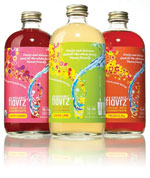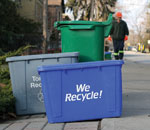
Keeping our eyes on the horizon helps us navigate better in turbulent seas.
Like boy scouts and marines, packaging professionals need to be prepared. Change is coming, as it always does.
But just because we know our lives and our businesses will evolve, that doesn’t necessarily mean we will be ready or will even know how to get ready.
Perhaps some of these thoughtful predictions will help…

Concentrates efficiently deliver product with a minimum of packaging. One 16-ounce glass bottle contains enough Flavrz low-sugar liquid drink concentrate that, when mixed with water, makes 30 to 40 individual servings.
For years, product manufacturers have done what they could to optimize transportation efficiencies by not shipping air (such as nesting empty containers or minimizing headspace in filled packages). Now, to save costs and score environmental points, processors will reassess why they’re shipping so much water, too. (Many facilities have already reduced the amount of water used during processing for the same reasons.)
With the right marketing spin, consumers could quickly accept these short-prep products. Think of the successful marriage of bottled water and powdered beverage flavorings in stick packs. Perhaps these foods and beverages will taste fresher, which is always a positive.
Perhaps concentrated products will cost less. After all, Campbell Soup was pretty successful with its “value” campaign last fall when the economy tanked. The company reminded consumers that its affordable condensed soups are formulated without water, which households easily add later for free.
Perhaps dry concentrated products will be inherently safer. After all, many bacteria, such as Salmonella, need moisture to spawn.
Perhaps these products, especially dry concentrates, won’t need refrigeration and will have longer shelf life and wider distribution reach.
PREDICTION: Terrorists will attack our food supply. I pray they’re not successful. Unfortunately, praying alone will not make it so. That’s why the government will intervene, and probably sooner then you think (read about possible upcoming regulations inResponsibility in the 21st Century). New laws will force processors to secure and identify their products, all the way down to raw ingredients.
A terrorist attack would spur innovations in packaging security features, just like the 1982 Tylenol tamperings gave birth to a flurry of tamper-evident features for over-the-counter pharmaceuticals and other consumable products. We’ll need more options for facility and cargo security, as well as anti-counterfeiting and track-and-trace packaging technologies. (Also see “Top 5 technologies of the future” on p.36 for promising new technologies in the area of microbial safety.)
For track-and-trace, managing and protecting all the data compiled from various links in the supply chain will create jobs in a whole new department. Director of Master Data Management will become a coveted career.

Recycling efforts will pick up in America as infrastructures are built around new materials, such as polypropylene.
Recycling businesses will have to compete against new applications of waste-to-energy (W2E), though.
PREDICTION: Small-scale solutions will outperform grandiose plans. In the far future, houses will generate their own energy from their own waste in closed-loop systems. Before that, though, small-scale closed-loop systems will prove their value at the municipal level.
Waste-to-energy plants (incinerators) are highly efficient. Only 10% of garbage burned remains as ash, and that can be used in road construction or buried in a landfill. But Americans have a not-in-my-backyard attitude toward W2E plants. They don’t want the noise and traffic of smelly garbage trucks in the neighborhood. And they rarely see any direct energy cost savings.
Now, think about how many if not all of those problems disappear when the W2E facility serves a small area of a community, say two square miles of residential and commercial sites. A similar project is already underway in Dublin, Ohio.
Corey Linden, research scientist, Advanced Materials Applications, at Battelle, outlined several other benefits of small-scale W2E operations at the fall 2008 meeting of the Flexible Packaging Association:
• Reduced waste handling and trucking costs.
• Reduced overall carbon footprint.
• Direct community involvement from consumers and local businesses.
Here’s another reason to think big about small-scale ideas. Perhaps major manufacturing locations that feed central distribution hubs will be replaced with more but smaller regional manufacturing plants. Then food and beverage processors can promote “Buy Local!” more often, as well as connect better with communities. They’ll also gain more efficient and economical distribution.
Packaging machines and complete packaging lines will get smaller, too (possibly due to floor space constraints in these smaller plants). Systems with fewer parts, compact footprints and minimal steps will help speed up changeovers between short runs.
PREDICTION: Grocery stores will drive more innovation in packaging. I’m not talking about sophisticated packaging for store brands, although that trend will continue. Sooner or later, some retailer will make major changes to store layouts and displays to make them more shopper-friendly.
Perhaps supermarkets will create a Meal Center, where everything for a particular dinner menu is within just a few steps. Angel-hair pasta, sauce, meatballs or sausage, grated parmesan cheese, garlic bread, wine and cheesecake. Or steak, steak sauce, McCormick Grill Mate spices, potatoes, butter, bacon bits, sour cream, chives, fried shrimp, cocktail sauce, wine coolers and brownies. Shoppers will concede some limit on options here to save time.
Perhaps grocers will set up a full-time concierge desk, to help customers with meal or party planning (or with spring cleaning tips). Computers could then print out menus, along with a floor plan of the store showing exactly where all the items are (maybe with coupons, too). What a time saver!
Perhaps retailers will find an economical way to deliver groceries direct to customers at home, maybe through the postal service since mail trucks visit nearly every house every day anyway. How will primary packages be designed to withstand the rigors of small-parcel delivery?
Perhaps store designers will develop an automated system of restocking shelves (mechanically or with robots). More machine handling might require higher scuff resistance on package surfaces or easy-to-handle groups of shelf-ready packages.

Packaging is key to fighting world hunger. It prevents massive food waste by protecting foods and beverages from post-harvest through consumption.
PREDICTION: Packaging machines will conform to communication standards, easing packaging line installation, operation and maintenance. The Open Modular Architecture Controls (OMAC) Packaging Workgroup has been working on these since 1995. Continued global competition will compel packaging machinery manufacturers to embrace OMAC standards (which have been ratified internationally) as a positive point of differentiation.
PREDICTION: Like most predictions, in the future some will have turned out to be right (cross my fingers) and some will not (big sigh). Won’t it be fun finding out which?

WEB EXCLUSIVE: Virtual impact
PREDICTION: Packaging departments will find surprising new uses for the virtual world, such as social media sites and simulation.Do you have an avatar? Don’t even know what an avatar is? You’ve got some catching up to do. An avatar is an image that represents you in the virtual world of the internet. What do you need that for? A lot, it seems. The list of social media websites continues to grow. Twitter. Facebook. LinkedIn. MySpace. How connected are you personally? Professionally? While the specific sites may come and go in time, this mode of communication is here to stay.
We’re still learning how social media sites can benefit businesses. But perhaps it’ll turn out to be the best and fastest way to find new people with just the solution we need at the time we need it. Like the six degrees of separation, every packaging professional can connect with any other packaging professional in the world through their extensive online network.
The virtual world isn’t just about social networking, though. It’s a great scientific tool, too. Perhaps simulation can speed up shelf-life tests. Or help with consumer research (seeTop 5 technologies of tomorrowand look forOptimization/Simulation SoftwareandHolographic Imaging).
There’s virtually no limit on creativity in the virtual world!
